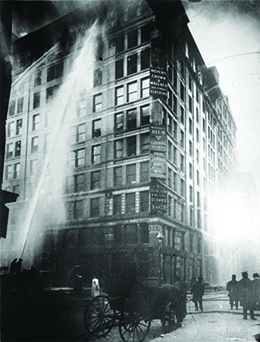| << Chapter < Page | Chapter >> Page > |

The tragedy of the Triangle Shirtwaist Factory fire was a painful wake-up call to a country that was largely ignoring issues of poor working conditions and worker health and safety. While this fire was far from the only instance of worker death, the sheer number of people killed—almost one hundred fifty—and the fact they were all young women, made a strong impression. Furthering the power of this tragedy was the first-hand account shared by William Shepherd, a United Press reporter who was on the scene, giving his eyewitness account over a telephone. His account appeared, just two days later, in the Milwaukee Journal , and word of the tragedy spread from there. Public outrage over their deaths was enough to give the National Consumers League the power it needed to push politicians to get involved.
I saw every feature of the tragedy visible from outside the building. I learned a new sound—a more horrible sound than description can picture. It was the thud of a speeding, living body on a stone sidewalk.
Thud-dead, thud-dead, thud-dead, thud-dead.Sixty-two thud-deads. I call them that, because the sound and the thought of death came to me each time, at the same instant. There was plenty of chance to watch them as they came down. The height was eighty feet.
The first ten thud-deads shocked me. I looked up—saw that there were scores of girls at the windows. The flames from the floor below were beating in their faces. Somehow I knew that they, too, must come down. . . .
A policeman later went about with tags, which he fastened with wires to the wrists of the dead girls, numbering each with a lead pencil, and I saw him fasten tag no. 54 to the wrist of a girl who wore an engagement ring. A fireman who came downstairs from the building told me that there were at least fifty bodies in the big room on the seventh floor. Another fireman told me that more girls had jumped down an air shaft in the rear of the building. I went back there, into the narrow court, and saw a heap of dead girls. . . .
The floods of water from the firemen’s hose that ran into the gutter were actually stained red with blood. I looked upon the heap of dead bodies and I remembered these girls were the shirtwaist makers. I remembered their great strike of last year in which these same girls had demanded more sanitary conditions and more safety precautions in the shops. These dead bodies were the answer.
What do you think about William Shepherd’s description? What effect do you think it had on newspaper readers in the Midwest?
Another cause that garnered support from a key group of Progressives was the prohibition of liquor. This crusade, which gained followers through the Women’s Christian Temperance Union (WCTU) and the Anti-Saloon League, directly linked Progressivism with morality and Christian reform initiatives, and saw in alcohol both a moral vice and a practical concern, as workingmen spent their wages on liquor and saloons, often turning violent towards each other or their families at home. The WCTU and Anti-Saloon League moved the efforts to eliminate the sale of alcohol from a bar-to-bar public opinion campaign to one of city-to-city and state-by-state votes ( [link] ). Through local option votes and subsequent statewide initiatives and referendums, the Anti-Saloon League succeeded in urging 40 percent of the nation’s counties to “go dry” by 1906, and a full dozen states to do the same by 1909. Their political pressure culminated in the passage of the Eighteenth Amendment to the U.S. Constitution, ratified in 1919, which prohibited the manufacture, sale, and transportation of alcoholic beverages nationwide.

Notification Switch
Would you like to follow the 'U.s. history' conversation and receive update notifications?